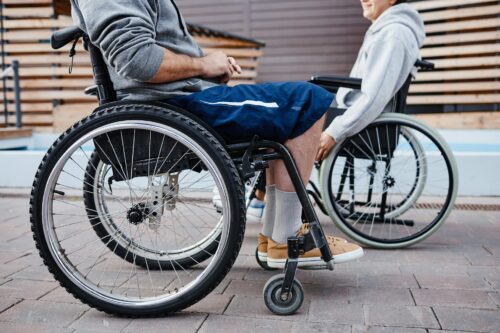Why the Wrong Wheelchair Ramp Slope Can Cause Problems

When thinking about wheelchair ramps, the slope might not be the first thing that comes to mind. Yet, it’s a crucial element that affects how easy and safe the ramp is to use. Imagine a ramp that is too steep—it can turn a simple task into a challenging chore. The right slope ensures users can move comfortably and safely, whether they’re going up or down. It also provides a sense of security, making every outing less stressful and more enjoyable.
The wrong slope can bring a host of problems. Users might struggle to maintain control or may even face the risk of tipping. Anyone who uses a wheelchair regularly knows the importance of feeling secure when using a ramp. It’s not just about convenience; it’s about safety and accessibility for everyone. This is especially true in a city like Ottawa, where the weather adds another layer of challenge with snow and rain affecting the use of ramps.
Understanding Wheelchair Ramp Slope
So, what exactly is a wheelchair ramp slope? Simply put, it’s the angle of the ramp, which determines how steep it is. The slope is usually expressed as a ratio, like 1:12, meaning for every inch of vertical rise, there are 12 inches of ramp run. This helps ensure a gentle incline, making it easier for wheelchair users to navigate.
In Ottawa and across Canada, there are guidelines that specify the recommended slope for public and residential ramps. Generally, the recommended slope for wheelchair ramps should provide a gradual incline. It’s not just a matter of preference; these standards are designed to keep everyone safe. A correctly designed slope minimizes the effort required and maximizes stability.
To give you some perspective, think of it like a gentle hill your wheelchair needs to travel up. The less steep it is, the easier it is to climb. A steep hill makes it harder to push against gravity, much like a steep ramp would for someone who uses a wheelchair. Following the recommended guidelines ensures the ramp is not only safe but also usable by everyone, regardless of strength or ability.
Understanding these principles is key to designing or evaluating a ramp for safety and accessibility. By ensuring that ramps meet these standards, we can help prevent accidents and make public spaces more inclusive.
Safety Concerns with the Wrong Slope
Getting the slope right isn’t just a matter of making life easier for wheelchair users; it’s primarily about safety. An incorrect slope can lead to serious safety issues. A ramp that’s too steep becomes challenging to ascend or descend. Imagine the stress and potential danger if a user loses control or their wheelchair tips over. This is why getting the angle right is so critical.
In Ottawa, known for its snowy winters, safety concerns become even more pressing. Slippery ramps are already difficult, but a ramp with the wrong slope makes navigation even more treacherous. Smaller, everyday tasks, like heading out for groceries, can turn into daunting endeavours. Safety is paramount not only for the person using the wheelchair but also for anyone assisting them.
Here are a few concerns when slopes aren’t correct:
– Risk of falls and tipping over
– Increased difficulty in pushing or operating a wheelchair
– Strain and fatigue in users and caregivers
– Potential hazards from weather conditions like ice or rain
Thinking about these factors helps underline the importance of proper ramp construction.
Accessibility Issues
Having the wrong slope impacts more than just safety; it can severely limit accessibility. A ramp that is too steep or too shallow doesn’t meet the standards set out to help everyone access public spaces freely. Accessibility isn’t just about complying with building codes—it’s about ensuring everyone can participate equally in society.
If ramps aren’t accessible, it could mean missing out on daily routines or social activities. For residents in Ottawa, the terrain adds challenges, making proper ramp design a necessity, not a luxury. It’s essential to think about all users, recognizing that everyone has a right to access buildings comfortably and independently.
Accessibility issues most commonly caused by wrong slopes include:
– Limited or blocked access to buildings and spaces
– Increased reliance on assistance from others
– Frustration and decreased independence for users
Ensuring the Right Ramp Slope
Ensuring the ramp slope is correct is key to preventing both safety and accessibility issues. Professional installation is the best way to make sure all regulations and personal needs are met. Regular maintenance should not be overlooked either, as it keeps the ramp in top condition despite Ottawa’s unpredictable weather.
Here are a few tips for achieving the right ramp slope:
– Consult professionals who understand the local guidelines and personal needs
– Regularly inspect and maintain ramps to handle seasonal wear
– Test the ramp regularly to ensure it’s still performing as expected
A correct ramp slope supports safety, accessibility, and overall user confidence. This makes everyday activities easier and more pleasant. By taking these steps, individuals and communities create a welcoming environment that respects everyone’s needs.
For those looking to enhance both safety and accessibility in their daily lives, ensuring a proper wheelchair ramp slope is key. If you’re considering a new ramp installation or want to make sure your current one is up to standard, trust Regional Ramp for reliable solutions. Explore more by visiting our wheelchair ramp slope page to find options that cater to the unique demands of Ottawa’s landscape.

